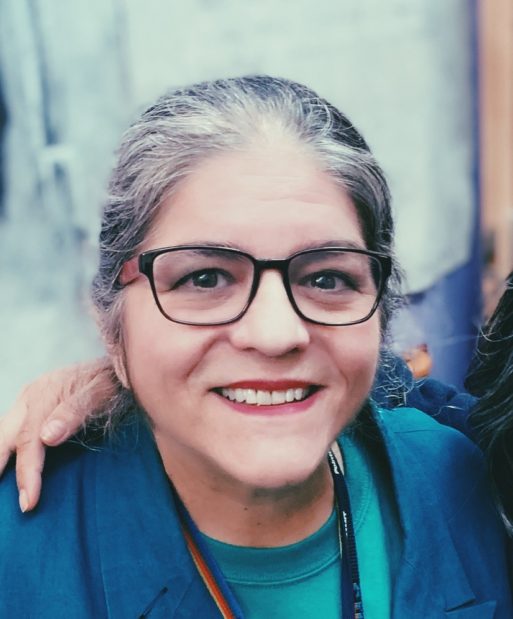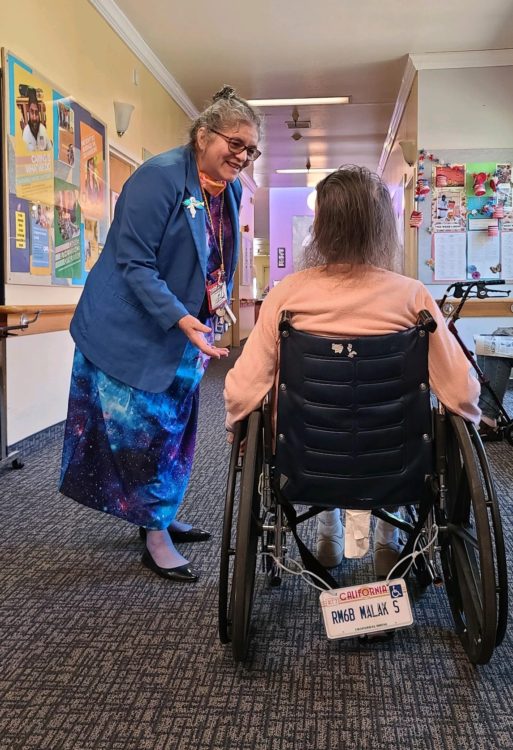
Licensed nursing home administrator, KJ Page, is hopeful that laws allowing for medical cannabis use in healthcare settings will expand across the country.
KJ Page is a registered nurse and board certified in gerontology. She has been caring for the elder population in myriads of roles for more than three decades, currently serving as administrator for Chaparral House, a non-profit skilled eldercare community in Berkeley, California. Her career has been dedicated to finding innovative person-centered solutions to problems that often plague the long-term healthcare system.
In this interview, nurse Page shares her professional and personal insight on California’s “Ryan’s Law.” Enacted January 1, 2022, Ryan’s Law is the first of its kind in the U.S. to mandate that medical cannabis be permissible for terminally-ill patients in all healthcare facilities, including hospitals and nursing homes. Ryan’s Law is named after Ryan Bartell, a dying patient who was unable to spend time with his family due to extreme lethargy caused by opiates used to control his pain. Ryan’s father ultimately moved his son to a facility where he was able to use medical cannabis to manage his symptoms in his final days. Ryan’s father told Times of San Diego, “Looking at each other, holding Ryan’s hand and telling him how much I loved him during his final moments would not have been possible without the medical cannabis.”
Editor’s Note: This interview has been edited for length and clarity.
First, as someone who has professionally cared for an elder population for 30 years, how or why do you consider medical cannabis beneficial for your patients?
With geriatric patients, we treat so many things with drugs. And each drug leads to side effects, so then we need to prescribe more drugs to take care of those side effects and so on. Cannabis has very few side effects with a large efficacy rate. Plus, there are many cells throughout the body that respond specifically to cannabinoids. These cells act like receptors, so obviously there is a benefit to cannabis beyond the stigma.
And then once it became legal for use, the elder population embraced it. It became easier to talk about it, use it, experiment with it. These people already have chronic illnesses that medications have not been helping much. They have been endlessly battling pain with medications that impede their ability to stay awake and have quality of life. People that use cannabis use far less opioids, are less sedated and have better symptom control and management. Once they see how well it works, they are all for it.

Credit: theartofdoingstuff.com
Ryan’s Law allows terminally-ill patients in healthcare facilities to use medical cannabis in edible form to treat end-of-life symptoms.
How do those benefits mirror or differ for terminally-ill patients?
That term “quality of life” defines how well we live. To really have quality of life when you live in a nursing home, you need to focus on the smaller things, as well as the big things. How can we get to “yes,” when there are so many ways of saying “no”? It makes it a lot easier to achieve a quality of life when you can use what works. Ryan’s Law makes that more possible for terminally ill patients, who can now use medical cannabis on the premises.
For those on hospice, it is mostly about relieving end-of-life symptoms without impeding their ability to continue to live a quality life. With medical cannabis, patients can get pain relief without sedation, so they can stay awake to enjoy time with their family. And without opioids, patients will not additionally suffer from excruciating constipation often caused by narcotic pain killers.
How exactly does Ryan’s Law play out for patients in facilities?
The law allows for edibles only. This is fine, as I think smoking or vaping in a skilled nursing facility or hospital is too dangerous. Although smoking or vaping may be more effective, the difference in efficacy is not worth the risk.
The most difficult thing about this law is that we, the medical professionals, cannot store, touch, or administer the medical cannabis. We are specifically prohibited from touching it. It is easier to manage cannabis use inside a patient’s home where we can keep it stored with narcotics and track its use. But now, that is only something the resident, or patient, can do for themselves.
And many of these patients can’t even raise a cup to their own mouth, let alone get cannabis out of their locked bedside cabinet, take it, and then remember to tell us about it. It is heartbreaking when they cannot get relief from something within arm’s reach. If they can’t get it out of their locked bedside drawer and administer it for themselves, then patients must rely on family to do that for them. Most patients also do not have family around 24/7. We do try to encourage friends of those patients or families or find volunteers to come in at night to assist the patient whenever possible.
This patient-specific stipulation was not in the initial bill. It was an eleventh-hour compromise to get the bill signed into law. We hope it will someday change. Other roadblocks include cost, as insurance companies do not cover cannabis, and accessibility. If you don’t have a registered caregiver to go get the cannabis for you, then how will you get it? Some dispensaries deliver, but staff are not allowed to sign for it.

KJ Page, RN interacts with a resident at Chaparral House in Berkeley, California.
Since a patient must self-administer the cannabis, how do medical staff track and manage its use?
Patients tell the nurse when they self-administer, or the nurse inquires when they know it is time. But for the most part, families are the ones reporting its use to medical staff.
The physician who recommends cannabis for patient use checks against other drugs or conditions when prescribing it. It is not yet common for pharmacists, who are often the ones to check for potential drug interactions, to do so. However, there are not many side effects or interactions with cannabis use to note. Caution may be used in patients who take blood thinners. Some studies show that cannabis may increase their effectiveness, so you simply monitor and use less if warranted. However, this is not a huge concern for those at end of life, as those patients typically do not take blood thinners regularly by that point.
Physicians might recommend certain strains to patients for symptom relief, but they do not prescribe specific dosages, much like other states where medical marijuana is legal. There is one dispensary in the Berkeley area that specializes in geriatric patients, so their bud tenders and nurse consultants have more experience when making specific recommendations for symptom relief. I do hope to see nurses more closely associated with larger dispensaries across the country overall.
However, no one has ever died of marijuana overdose! The worst thing that happens is that you can get too high. There is no cardiac arrest, no vomiting, no liver failure, no need for something like Narcan to reverse an overdose…nothing!
How do you see the future of cannabis as medicine here in the United States?
I think once marijuana is declassified by the FDA, there will be a lot more room for its use and administration in the medical field. There is more and more research to support its benefits. But until we get enough double-blind placebo-controlled studies, Western medicine won’t accept it. However, those studies that have been done so far are really promising. And I am hopeful that declassification will happen in my lifetime.
We also need to expand education for healthcare providers. Right now, the only way to get that is through an organization called Cannabis Nurses Network because medical and nursing schools aren’t teaching it. There are a few schools that are just starting to recognize the need for it. In the early nineties there were few or no schools that offered education in pain management. So, education is something that happens eventually and organically and this is just something gaining attention and it will eventually be taught. As these things unfold, more studies will happen, and medical practice follows. The Cannabis Nurses Network is also working to introduce legislation like Ryan’s Law in other states.
What can patients, families and advocates do to introduce or expand cannabis laws to include healthcare facilities in their state?
People who are sick can go to their legislators and make a compelling argument. It’s hard to argue with someone who is ill and only getting relief from cannabis (or, their grieving families). That’s the way to do it. Moms are fearless. The mothers that advocated for their kids with intractable epilepsy when marijuana was the only thing that worked for them were the ones that got national attention. Look what they accomplished for their children through Charlotte’s Web. They really started this whole process.
People should also know that the term marijuana has a sordid past. So, using the term “medical cannabis” is best when advocating for legal recognition. At some point the word marijuana was used in Mexico as a slur. And then movies like “Reefer Madness” depicted its use in a negative light. Many medical professionals prefer the term cannabis over marijuana because it represents the plant’s overall medicinal properties best.

 California’s “Ryan’s Law” Allows Medical Cannabis Use in Healthcare Facilities
California’s “Ryan’s Law” Allows Medical Cannabis Use in Healthcare Facilities


 “Songbird” by Fleetwood Mac
“Songbird” by Fleetwood Mac
 First the Wealth Gap, Now the U.S. Has a Growing Health Gap
First the Wealth Gap, Now the U.S. Has a Growing Health Gap















